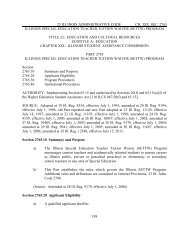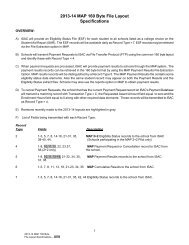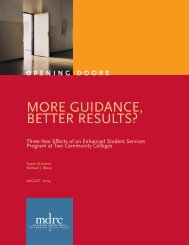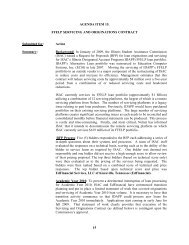High school rigor and good advice: Setting up students to succeed
High school rigor and good advice: Setting up students to succeed
High school rigor and good advice: Setting up students to succeed
Create successful ePaper yourself
Turn your PDF publications into a flip-book with our unique Google optimized e-Paper software.
federal government <strong>and</strong> a specific variable in the ELS survey. 4 We use 10 th grade st<strong>and</strong>ardized test<br />
scores as a proxy for a student’s previous academic achievement. 5<br />
In no way should this suggest that all <strong>students</strong> with a low SES have low academic achievement or those<br />
<strong>students</strong> with high SES will have high academic achievement. There are many <strong>students</strong> that have a low<br />
SES <strong>and</strong> a very high 10 th grade st<strong>and</strong>ardized scores, but they are outside of the scope of this report.<br />
These gro<strong>up</strong>ings are meant <strong>to</strong> demonstrate the effects that the variables of this report have on gro<strong>up</strong>s<br />
that traditionally have a better chance of persisting <strong>and</strong> <strong>students</strong> who have a worse chance of persisting.<br />
It is also important <strong>to</strong> note that the <strong>students</strong> in this study were in college before the global recession hit<br />
in 2008. While financial concerns do have a role in persistence, these findings are not affected by the<br />
recession. For this report the following gro<strong>up</strong>s refer <strong>to</strong>:<br />
<strong>High</strong> SES/Achievement Gro<strong>up</strong>: Students with a high level of SES <strong>and</strong> high prior academic<br />
achievement. These <strong>students</strong> have a higher chance of persistence than the other student gro<strong>up</strong>s<br />
Middle SES/Achievement Gro<strong>up</strong>: Students with an average level of SES <strong>and</strong> average prior academic<br />
achievement. This gro<strong>up</strong> represents <strong>students</strong> with neither a high or low chance of persisting<br />
Low SES/Achievement Gro<strong>up</strong>: Students with a low level of SES <strong>and</strong> below low prior academic<br />
achievement. These <strong>students</strong> have a lower chance of persistence than the other gro<strong>up</strong>s<br />
<strong>High</strong> SES/Achievement Gro<strong>up</strong>: These <strong>students</strong> have above average levels of SES, the 61 st <strong>to</strong> 80 th<br />
percentile (4 th quintile) of all <strong>students</strong>. SES can represent an economic or social position in comparison<br />
<strong>to</strong> other <strong>students</strong>. Students with a high SES could have any combination of family income, parents’<br />
education, or any of the five fac<strong>to</strong>rs that make <strong>up</strong> the SES variable in ELS 2002 data that would rank it<br />
higher than the other <strong>students</strong>. 6 This ranking is highly correlated with academic success including<br />
persistence in college. <strong>High</strong> SES/achievement <strong>students</strong> also had above average scores on 10 th grade<br />
st<strong>and</strong>ardized tests (61 st <strong>to</strong> 80 th percentile or 4 th quintile). This gro<strong>up</strong> attempts <strong>to</strong> show the effects that<br />
the variables in this report have on persistence for <strong>students</strong> who already have a better-than-most<br />
chance of persistence.<br />
Middle SES/Achievement Gro<strong>up</strong>: Students in this gro<strong>up</strong> are in the middle levels of SES. They also scored<br />
in the middle range on their 10 th grade st<strong>and</strong>ardized tests. They are in the 41 st <strong>to</strong> 60 th percentile of both<br />
characteristics (3 rd quintile). They represent a category of <strong>students</strong> that has no clear advantage or<br />
disadvantage over the other two gro<strong>up</strong>s when it comes <strong>to</strong> persistence in college.<br />
Low SES/Achievement Gro<strong>up</strong>: These <strong>students</strong> have below average levels of SES <strong>and</strong> scored lower on 10 th<br />
grade st<strong>and</strong>ardized tests, in the 21 st <strong>to</strong> 40 th percentile of both (2 nd quintile). This student gro<strong>up</strong><br />
represents <strong>students</strong> who persist at lower levels than the other two gro<strong>up</strong>s. The low SES could present<br />
financial concerns in college which could negatively impact their chances persisting. It is also important<br />
<strong>to</strong> note that <strong>students</strong> from low SES families are more likely <strong>to</strong> be first generation college <strong>students</strong> <strong>and</strong><br />
may be less familiar with college expectations <strong>and</strong> requirements, fac<strong>to</strong>rs which could prevent them from<br />
persisting. Similarly achieving <strong>students</strong> from higher SES families are more likely <strong>to</strong> have a family his<strong>to</strong>ry<br />
of going <strong>to</strong> college <strong>and</strong> would be more likely <strong>to</strong> persist.<br />
4












